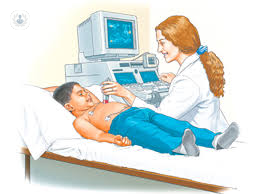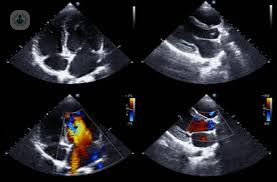Heart murmurs in childhood
Written by:Cardiac murmurs are central diagnostic elements to suspect the existence of congenital heart disease , whose incidence is 1%.
The auscultation of a murmur in Pediatrics is a frequent finding. It is an extra noise that is detected in the auscultation of the child and it is estimated that up to 80% of children will present at some stage of their life.
Blows are classified on an intensity scale of 1 to 6, with grade 1 being barely audible and 6 being very loud.
The main problem that we face before a child with a breath is to determine if it is pathological or not. This is why, referral to a Cardiologist with experience in Congenital Heart Disease is a very adequate option for the correct diagnosis of the type of murmur and the exclusion of any heart disease that causes the child to need a specific treatment and follow-up of his pathology.

Evaluation of heart murmur in children
- Anamnesis: The presence of any of these findings requires a more complete evaluation of the child:
- Breath in the first 48 hours of life and recommended in infants (since 1 in 7 infants with a murmur have underlying heart disease).
- In neonates and infants , difficulty feeding, poor weight gain, unexplained respiratory symptoms or cyanosis. In schoolchildren and adolescents, the presence of chest pain, syncope, exercise intolerance or palpitations.
- Antecedents of pregnancy: prematurity, maternal diabetes mellitus type 1, infections or medication.
- Family history: congenital heart disease, hypertrophic cardiomyopathy and sudden death in children under 40 years.
- General Physical Examination: The existence of any of these findings requires a more detailed evaluation:
- Skin: cyanosis.

- Chest configuration: asymmetries, malformations, scoliosis.
- Type of breathing: tachypnea.
- Weight and size: poor staturo-ponderal increase.
- Blood pressure: asymmetric parameters (control in the 4 limbs looking for aortic coarctation).
- Palpation of precordium and apex: displacement may indicate cardiomegaly.
- Liver palpation: signs of congestive heart failure.
- Dysmorphia (25% are associated with congenital heart disease).
- Skin: cyanosis.
- Auscultation: An auscultation can be considered pathological when it fulfills one of these criteria:
- Pansystolic murmur.
- Proto or mesosystolic clicks.
- Alteration of the second noise.
- Diastolic murmur.
- Intensity greater than III / VI.
- Rough or rough quality.
Innocent murmur versus pathological murmur
Innocent murmurs are defined as those who are auscultated in an absolutely normal heart during childhood or adolescence, and which has no clinical significance. Literature makes the difference with Functional Breath, which defines as a breath present in a healthy heart, but which presents in a secondary way to non-cardiac pathology (eg, thyrotoxicosis, anemia, fever).
Characteristics of innocent murmurs
In general terms the functional murmurs share some characteristics in common, which allows its suspicion:
- They are auscultated in children without precordial activity.
- Auscultation of the first noise (R1) normal.
- A dissociation of the second noise (R2) can be heard, but it is modified by breathing.
- When listening with the child in the supine position, the breath is heard "in diamond".
- When you listen to the child standing, the intensity of the breath decreases.
- With the exception of the "Hum" venous, all functional murmurs are systolic.
What is the most appropriate behavior before a blow?
- In the presence of warning signs: refer to a Cardiologist with experience in Child Cardiology for the realization of Echocardiography since it is the method that has a sensitivity and specificity that is around 100%.
- In the absence of warning signs, it will be necessary to differentiate according to the child's age:
- Under 6 months: if there is a high suspicion of Physiological Stricture of Pulmonary Branches is presented control until 6 months. If the murmur does not disappear, refer to the cardiologist.
- Between 6 months and 2 years: refer to the cardiologist for all the murmurs, considering the difficulty of examining these children and that 1 in 7 will be pathological.
- Over 2 years: assume as an innocent blow and educate parents in relation to the normality of the condition and the absence of restrictions. However, in most cases, the cardiologist is usually referred to confirm the absence of pathology by means of Doppler-Color Echocardiography.
The importance of the cardiologist in heart murmurs
Auscultation is the initial diagnostic method in innocent murmurs; however, it is necessary to supplement it with an anamnesis and a complete physical examination, and to look for signs of alarm.
The referral to the cardiologist with experience in Cardiology and Child Echocardiography should be performed in case of diagnostic doubt and always to children between 6 months and 2 years.
Echocardiogram is the method of choice to rule out congenital heart disease.




